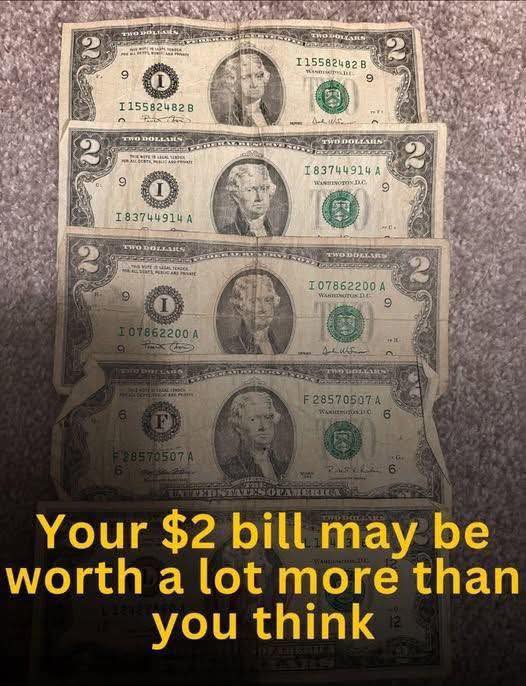For decades, the American $2 bill has existed in a unique space between currency and superstition. Some people thought it brought bad luck, others insisted it was cursed, and many simply didn’t know what to make of it. But the truth is far more interesting: the $2 bill is not unlucky at all. In fact, if you have one tucked away in a drawer or wallet, it could be worth far more than two dollars — in some cases, hundreds or even thousands.
Its unusual reputation comes from decades of misunderstanding. Despite what people think, $2 bills were never discontinued, never outlawed, and were never meant to be rare. They simply fell out of regular use. Most Americans don’t see them in circulation, so they assume they’re gone. This belief, reinforced by rumors and urban legends, made the bill even more mysterious.
In reality, the $2 bill was designed to be practical. When first issued, it was meant to simplify transactions that would normally require two $1 bills. But people resisted it from the start. Some found it awkward or unnecessary, while others disliked how it fit into cash registers. Superstitions soon followed: gamblers said it was unlucky, small business owners found it inconvenient, and some even believed it was linked to crime or corruption. It became the “odd” bill of American currency — widely printed, rarely used.
Ironically, this rejection is what made the $2 bill appealing to collectors. When a bill becomes unpopular, people stop spending it. They hide it in envelopes, birthday cards, or drawers “just because it’s unusual.” Decades later, many of these bills remain untouched in perfect condition — a key factor that boosts their collector value.
Of course, not every $2 bill is valuable. Most modern bills printed after 1976 are still worth face value unless they’re in pristine condition or have unique serial numbers. Collectors look for patterns: repeating digits, solid numbers, ladders, low serials, or unusual symmetry. A simple $2 bill with a lucky serial number can sell for $100 or more.
The older the bill, the higher its value. Early 20th-century bills, especially those with red or brown seals, can fetch hundreds depending on condition. Some 19th-century $2 bills — the oversized “horse blanket” notes — are prized museum pieces. And if you own a rare printing error or a short-run series, that’s when the real value appears. These unusual anomalies are exactly what collectors seek, and sellers are often shocked by what buyers will pay.
One major misconception is that $2 bills are no longer produced. The Bureau of Engraving and Printing still prints them, and millions exist. The problem is distribution: because they’re produced in smaller quantities and rarely requested at banks, they don’t circulate widely. Bank tellers often keep them in drawers unless specifically asked for. This invisibility fuels the myth of rarity.
But the rarity that matters isn’t how many exist — it’s how many remain in perfect condition. Most paper money gets crushed, folded, torn, or stained. But $2 bills, because they are often saved, tend to survive unscathed. That preservation has turned them into unexpected collector treasures.
Some people have stumbled onto small fortunes without realizing it. A grandmother’s envelope of “odd bills,” a father’s wallet keepsake, a forgotten stash in the attic — all have led to surprisingly valuable finds. One quirk of the $2 bill market is that value can shift quickly over time. A bill worth $20 ten years ago might be worth five times as much today simply because collectors want certain patterns or print runs.
Beyond collector hype, the $2 bill has a real place in American history. It has been printed in multiple designs, used during different economic eras, and carries symbols reflecting American identity. The back of the modern $2 bill features John Trumbull’s depiction of the signing of the Declaration of Independence — a central moment in the nation’s story. This historical connection adds another layer of appeal.
Despite its quirks, the $2 bill has quietly made a comeback in recent years. Some businesses and individuals use it intentionally to spark conversations or encourage people to think differently about currency. Tourists especially love receiving them as change because they feel like souvenirs. And once someone gets one, they often stash it away instead of spending it — continuing the cycle that keeps these bills out of circulation and fueling the myth that they are rare.
Collectors, historians, and curious savers all agree on one thing: never assume a $2 bill is worthless. Small details — the year, seal color, serial number, and printing quality — can turn a simple note into a surprising windfall. Even if a bill isn’t worth hundreds, many collectors will pay above face value for crisp, well-preserved examples. And because people store them for decades, the odds of finding one in excellent condition are higher than for other denominations.
The real story of the $2 bill is a perfect mix of misunderstanding, superstition, and overlooked value. What was once dismissed as strange or unlucky is now a sought-after piece of Americana, appreciated not only for its potential worth but for its history. The fact that it still circulates — albeit rarely — adds to its intrigue. Few pieces of currency spark curiosity the way a simple $2 bill does.
If you have one tucked away, don’t throw it out. Don’t spend it without checking it. Look for the year, condition, seal, and especially the serial number. You might be holding something far more valuable than you think.
Sometimes the things people ignore end up being the most valuable — and the $2 bill is the perfect example.
